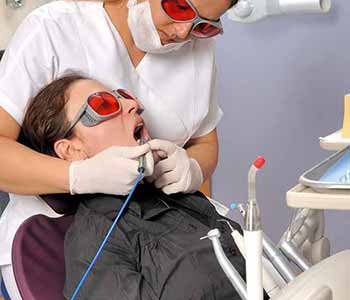Dentistry treatments utilizing Laser technology help treat gum disease for patients in Boston

At Quincy Smile Center, we are committed to helping our patients understand the signs, symptoms, and risk factors for gum disease. Prevention is a major pillar of our practice. By educating our patients about the progression of gum disease and how to prevent it, we can help empower our patients to protect their teeth and gums.
If gum disease is left untreated, it can progress quickly, destroy tissue and bone structure, and eventually lead to tooth loss. The good news is that it is almost entirely preventable.
What is gum disease?
Gum disease is an inflammation of the gums that can affect the health of a patient’s teeth, gums, and bones. It has two main stages: gingivitis and periodontal disease.
In its mildest form, gingivitis, it can be treated and reversed. Common symptoms of gingivitis include swelling of the gums, tender or bleeding gums, and chronic bad breath. Treatment for gingivitis involves a thorough professional cleaning to remove plaque and tartar from the mouth.
When gingivitis is left untreated, it can advance to periodontitis. Once it reaches this level, damage from the disease can no longer be reversed. When this happens, the gum begins to pull away from the teeth, leaving pockets that can collect bacteria and become infected. Symptoms of periodontal disease include receding gums, teeth that become loose or shift easily, deep pockets between the gums and teeth, bleeding gums, and bad breath. Periodontal disease is the leading cause of adult tooth loss in America.
Traditional treatment for periodontitis is much more invasive than it is for gingivitis. The good news is that we offer laser dentistry, which targets diseased tissue and leaves surrounding healthy tissue intact. Laser dentistry involves less bleeding and a quicker recovery period. Laser periodontal treatment is usually completed in several different appointments.
Prevention
To prevent gum disease, patients are encouraged to practice good oral hygiene habits, which include brushing twice per day and flossing once per day. In addition to taking care of your teeth at home, following these steps can help prevent gum disease:
- Eating a well-balanced diet, which is important in helping the body’s immune system
- Visit the dentist twice each year for professional cleanings to remove plaque and tartar
- Quit smoking
- Try to avoid grinding or clenching teeth
If you have been diagnosed with gum disease, please contact us at (617) 405-3939 for more information on the advantages of laser treatment.
Share this Article
Back to Laser Dentistry Page


















